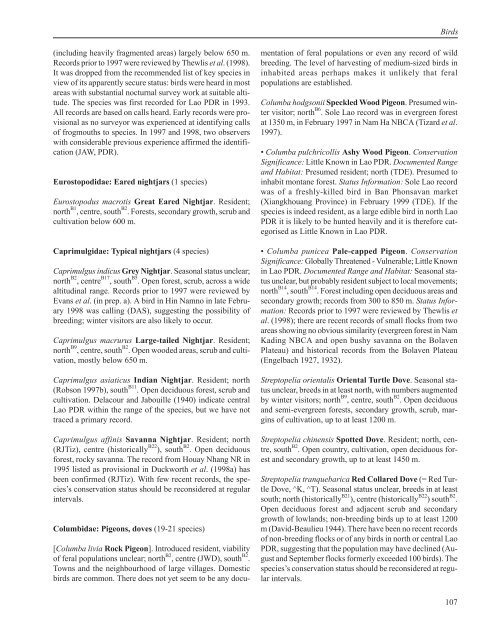Wildlife of Lao PDR: 1999 Status Report - IUCN
Wildlife of Lao PDR: 1999 Status Report - IUCN
Wildlife of Lao PDR: 1999 Status Report - IUCN
You also want an ePaper? Increase the reach of your titles
YUMPU automatically turns print PDFs into web optimized ePapers that Google loves.
(including heavily fragmented areas) largely below 650 m.<br />
Records prior to 1997 were reviewed by Thewlis et al. (1998).<br />
It was dropped from the recommended list <strong>of</strong> key species in<br />
view <strong>of</strong> its apparently secure status: birds were heard in most<br />
areas with substantial nocturnal survey work at suitable altitude.<br />
The species was first recorded for <strong>Lao</strong> <strong>PDR</strong> in 1993.<br />
All records are based on calls heard. Early records were provisional<br />
as no surveyor was experienced at identifying calls<br />
<strong>of</strong> frogmouths to species. In 1997 and 1998, two observers<br />
with considerable previous experience affirmed the identification<br />
(JAW, <strong>PDR</strong>).<br />
Eurostopodidae: Eared nightjars (1 species)<br />
Eurostopodus macrotis Great Eared Nightjar. Resident;<br />
north B1 , centre, south B2 . Forests, secondary growth, scrub and<br />
cultivation below 600 m.<br />
Caprimulgidae: Typical nightjars (4 species)<br />
Caprimulgus indicus Grey Nightjar. Seasonal status unclear;<br />
north B2 , centre B17 , south B5 . Open forest, scrub, across a wide<br />
altitudinal range. Records prior to 1997 were reviewed by<br />
Evans et al. (in prep. a). A bird in Hin Namno in late February<br />
1998 was calling (DAS), suggesting the possibility <strong>of</strong><br />
breeding; winter visitors are also likely to occur.<br />
Caprimulgus macrurus Large-tailed Nightjar. Resident;<br />
north B9 , centre, south B2 . Open wooded areas, scrub and cultivation,<br />
mostly below 650 m.<br />
Caprimulgus asiaticus Indian Nightjar. Resident; north<br />
(Robson 1997b), south B11 . Open deciduous forest, scrub and<br />
cultivation. Delacour and Jabouille (1940) indicate central<br />
<strong>Lao</strong> <strong>PDR</strong> within the range <strong>of</strong> the species, but we have not<br />
traced a primary record.<br />
Caprimulgus affinis Savanna Nightjar. Resident; north<br />
(RJTiz), centre (historically B22 ), south B2 . Open deciduous<br />
forest, rocky savanna. The record from Houay Nhang NR in<br />
1995 listed as provisional in Duckworth et al. (1998a) has<br />
been confirmed (RJTiz). With few recent records, the species’s<br />
conservation status should be reconsidered at regular<br />
intervals.<br />
Columbidae: Pigeons, doves (19-21 species)<br />
[Columba livia Rock Pigeon]. Introduced resident, viability<br />
<strong>of</strong> feral populations unclear; north B2 , centre (JWD), south B2 .<br />
Towns and the neighbourhood <strong>of</strong> large villages. Domestic<br />
birds are common. There does not yet seem to be any docu-<br />
Birds<br />
mentation <strong>of</strong> feral populations or even any record <strong>of</strong> wild<br />
breeding. The level <strong>of</strong> harvesting <strong>of</strong> medium-sized birds in<br />
inhabited areas perhaps makes it unlikely that feral<br />
populations are established.<br />
Columba hodgsonii Speckled Wood Pigeon. Presumed winter<br />
visitor; north B6 . Sole <strong>Lao</strong> record was in evergreen forest<br />
at 1350 m, in February 1997 in Nam Ha NBCA (Tizard et al.<br />
1997).<br />
• Columba pulchricollis Ashy Wood Pigeon. Conservation<br />
Significance: Little Known in <strong>Lao</strong> <strong>PDR</strong>. Documented Range<br />
and Habitat: Presumed resident; north (TDE). Presumed to<br />
inhabit montane forest. <strong>Status</strong> Information: Sole <strong>Lao</strong> record<br />
was <strong>of</strong> a freshly-killed bird in Ban Phonsavan market<br />
(Xiangkhouang Province) in February <strong>1999</strong> (TDE). If the<br />
species is indeed resident, as a large edible bird in north <strong>Lao</strong><br />
<strong>PDR</strong> it is likely to be hunted heavily and it is therefore categorised<br />
as Little Known in <strong>Lao</strong> <strong>PDR</strong>.<br />
• Columba punicea Pale-capped Pigeon. Conservation<br />
Significance: Globally Threatened - Vulnerable; Little Known<br />
in <strong>Lao</strong> <strong>PDR</strong>. Documented Range and Habitat: Seasonal status<br />
unclear, but probably resident subject to local movements;<br />
north B14 , south B14 . Forest including open deciduous areas and<br />
secondary growth; records from 300 to 850 m. <strong>Status</strong> Information:<br />
Records prior to 1997 were reviewed by Thewlis et<br />
al. (1998); there are recent records <strong>of</strong> small flocks from two<br />
areas showing no obvious similarity (evergreen forest in Nam<br />
Kading NBCA and open bushy savanna on the Bolaven<br />
Plateau) and historical records from the Bolaven Plateau<br />
(Engelbach 1927, 1932).<br />
Streptopelia orientalis Oriental Turtle Dove. Seasonal status<br />
unclear, breeds in at least north, with numbers augmented<br />
by winter visitors; north B9 , centre, south B2 . Open deciduous<br />
and semi-evergreen forests, secondary growth, scrub, margins<br />
<strong>of</strong> cultivation, up to at least 1200 m.<br />
Streptopelia chinensis Spotted Dove. Resident; north, centre,<br />
south B2 . Open country, cultivation, open deciduous forest<br />
and secondary growth, up to at least 1450 m.<br />
Streptopelia tranquebarica Red Collared Dove (= Red Turtle<br />
Dove, ^K, ^T). Seasonal status unclear, breeds in at least<br />
south; north (historically B21 ), centre (historically B22 ) south B2 .<br />
Open deciduous forest and adjacent scrub and secondary<br />
growth <strong>of</strong> lowlands; non-breeding birds up to at least 1200<br />
m (David-Beaulieu 1944). There have been no recent records<br />
<strong>of</strong> non-breeding flocks or <strong>of</strong> any birds in north or central <strong>Lao</strong><br />
<strong>PDR</strong>, suggesting that the population may have declined (August<br />
and September flocks formerly exceeded 100 birds). The<br />
species’s conservation status should be reconsidered at regular<br />
intervals.<br />
107

















